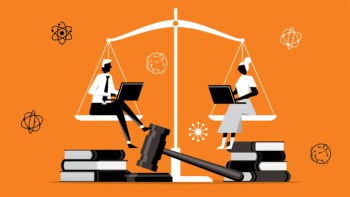
A silicon-based device that performs two functions vital for error correction in quantum computers has been created by an international team of researchers. The device was produced using conventional semiconductor manufacturing processes, and the team now hopes to scale up the technology to create a silicon-based quantum-computer chip.
The device can write quantum information to an individual spin and can also readout data from a pair of spins. While both these actions have been accomplished on silicon-based technologies before, the team says this is the first time both have been performed simultaneously on the same device.
Quantum computers use quantum bits, or qubits, for information storage. Unlike a conventional bit, which can have the value 0 or 1, a qubit can be in a quantum superposition of both 0 and 1. One way of achieving this is to use the spin of an electron as a qubit – with the spin pointing up corresponding to 0, for example, and spin down corresponding to 1.
Quantum dots
Spin qubits have already been created using tiny pieces of semiconductors called quantum dots. In 2015 researchers lead by Andrew Dzurak at the University of New South Wales (UNSW) in Australia coupled two such qubits together to create a controlled NOT (CNOT) gate – which is a fundamental component of quantum computers.
The two quantum dots were made by placing an array of electrodes on top of a piece of silicon-28, which is the most common silicon isotope. By applying voltages to some of the electrodes, two electrons are trapped within the silicon, separated by about 100 nm. The researchers then showed that they can adjust the spin state of one of the electrons without disturbing its neighbour, a process known as single-spin addressability.
The spin states are set by generating a microwave pulse using one of the electrodes as an antenna – a technique known as electron spin resonance (ESR). The states of the spin qubits can be set individually by using the electrodes to apply an electric field to one of the spins, which changes how that spin responds to the microwave signal.
Pauli spin blockade
Now, Dzurak and colleagues at UNSW, Delft University of Technology in the Netherlands, Keio University in Japan, and HRL Laboratories in the US have added a single-electron-transistor sensor to the two-qubit logic gate. This allowed them to make a quantum readout of both qubits using Pauli spin blockade while controlling the spin of the individual electrons using ESR. A Pauli spin blockade is a phenomenon that allows a measurement to be made on the singlet-triplet quantum state created when two electrons occupy a double quantum dot.
While none of the techniques demonstrated in the paper are new, combining them in one device is novel. According to the researchers, combining single-spin control with a readout based on Pauli spin blockade is a key requirement for quantum error correcting codes that will be necessary to ensure accuracy in large spin-based quantum computers.
“We’ve demonstrated the ability to do Pauli spin readout in our silicon qubit device but, for the first time, we’ve also combined it with spin resonance to control the spin,” says Dzurak. “This is an important milestone for us on the path to performing quantum error correction with spin qubits, which is going to be essential for any universal quantum computer.”
Key requirement
Lead researcher Michael Fogarty, who has now moved from UNSW to University College London, adds, “Quantum error correction is a key requirement in creating large-scale useful quantum computing because all qubits are fragile, and you need to correct for errors as they crop up.”

Silicon device reads and writes quantum information
Working in silicon is important because the low-cost material has been at the heart of the global computer industry for almost 60 years, so its properties are well understood, the researchers say. The team is now working with a consortium of industry and other universities with the target of producing a 10-qubit demonstration device in silicon by 2022, as the forerunner to creating a silicon-based quantum computer.
“By using silicon CMOS technology we have the ideal platform to scale to the millions of qubits we will need, and our recent results provide us with the tools to achieve spin qubit error-correction in the near future,” Dzurak says. “It’s another confirmation that we’re on the right track. And it also shows that the architecture we’ve developed at UNSW has, so far, shown no roadblocks to the development of a working quantum computer chip.”
The new device is described in Nature Communications.



